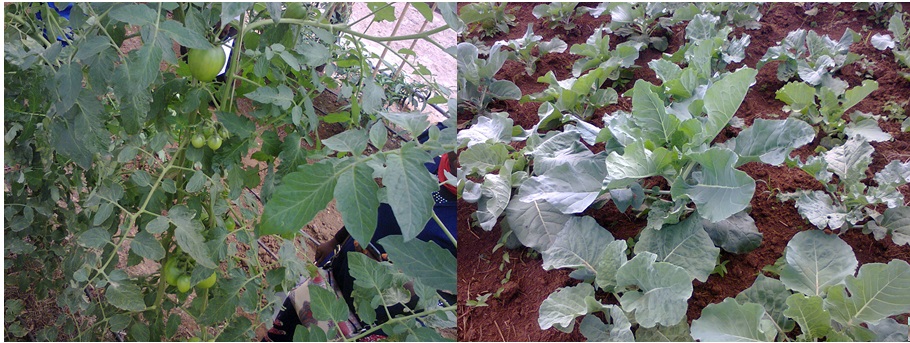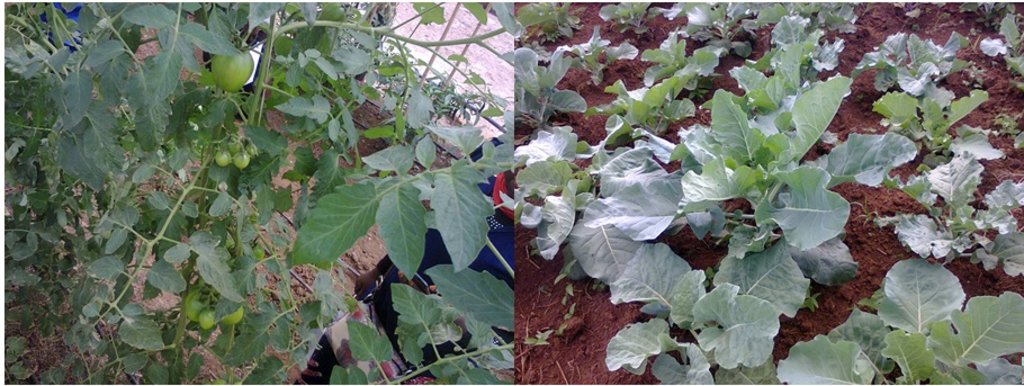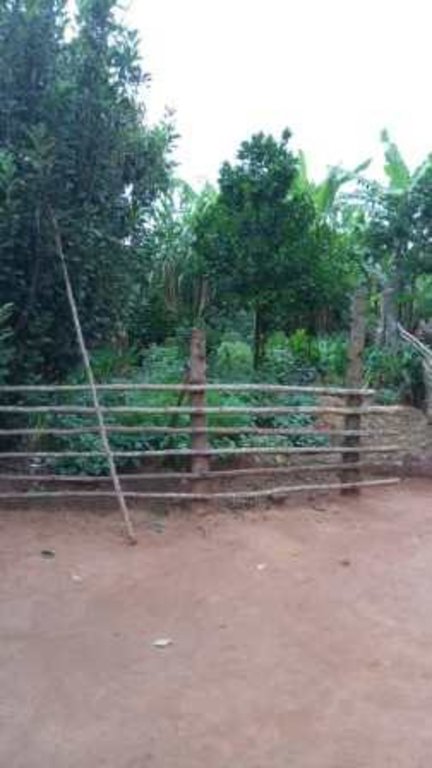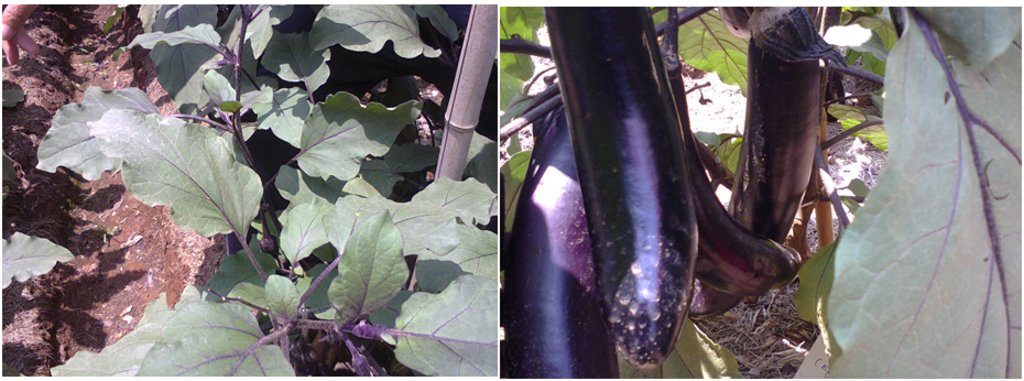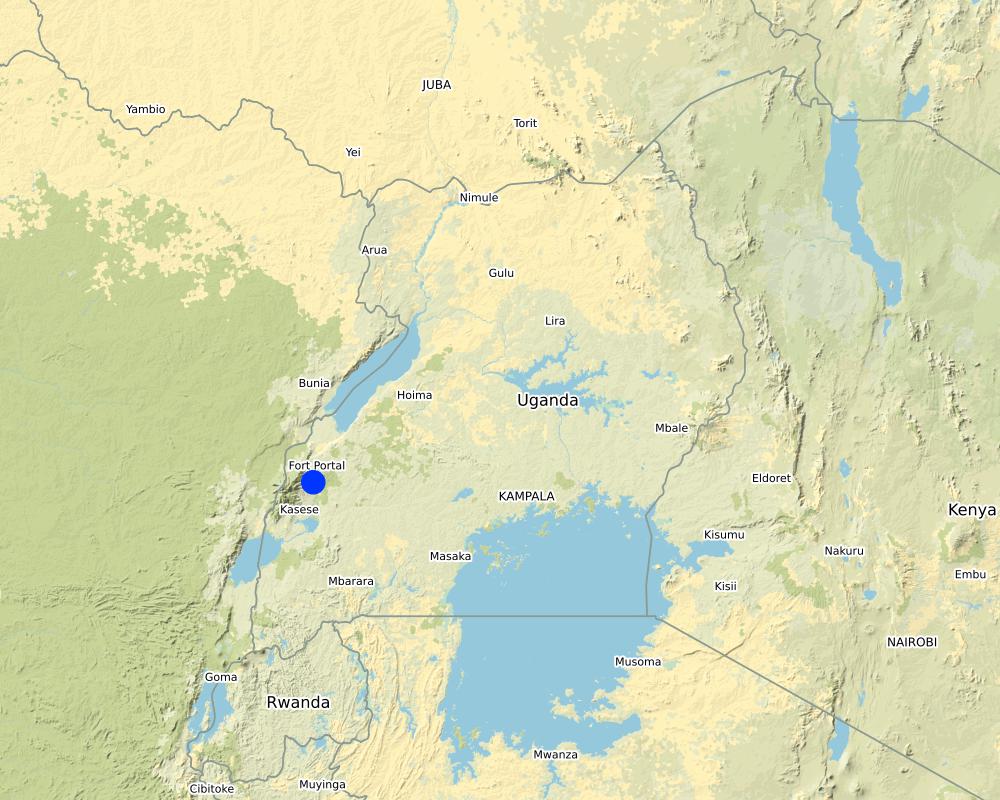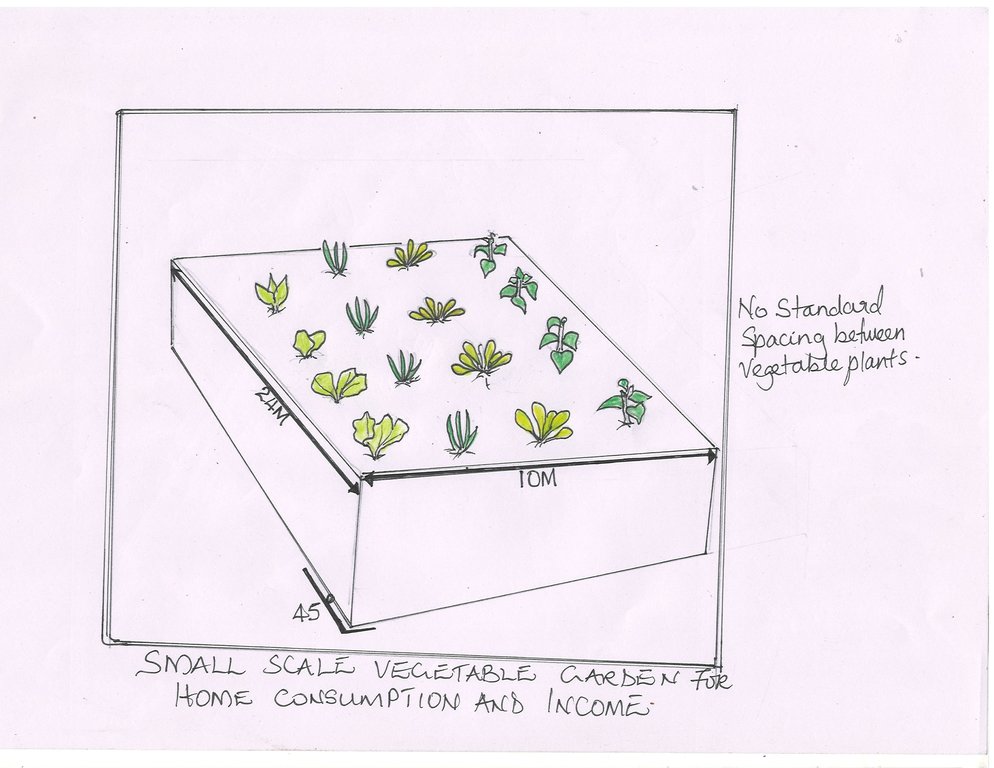Small Scale Vegetable Garden for Home Consumption and Income [Uganda]
- Creation:
- Update:
- Compiler: PRISCILLA VIVIAN KYOSABA
- Editor: Kamugisha Rick Nelson
- Reviewers: Nicole Harari, Udo Höggel
Obusiri bukye bwemboga bwokuriisa eka ahamwe nokuguza
technologies_3484 - Uganda
View sections
Expand all Collapse all1. General information
1.2 Contact details of resource persons and institutions involved in the assessment and documentation of the Technology
Key resource person(s)
land user:
Margaret Baguma
Kabarole District Local Government
Kabarole District, Western Uganda
Uganda
Name of project which facilitated the documentation/ evaluation of the Technology (if relevant)
Scaling-up SLM practices by smallholder farmers (IFAD)Name of the institution(s) which facilitated the documentation/ evaluation of the Technology (if relevant)
National Agricultural Research Organisation (NARO) - Uganda1.3 Conditions regarding the use of data documented through WOCAT
When were the data compiled (in the field)?
20/05/2017
The compiler and key resource person(s) accept the conditions regarding the use of data documented through WOCAT:
Yes
1.4 Declaration on sustainability of the described Technology
Is the Technology described here problematic with regard to land degradation, so that it cannot be declared a sustainable land management technology?
No
2. Description of the SLM Technology
2.1 Short description of the Technology
Definition of the Technology:
A vegetable garden (also known as a vegetable patch or vegetable plot) is a technology promoted by small and medium scale farmers in Western Uganda to grow vegetables and other plants namely spinach, egg plants, sukuma wiki, onions and tomatoes for human consumption and income usually established in backyards.
2.2 Detailed description of the Technology
Description:
The vegetable varieties grown are egg plants, spinach, sukuma wiki, tomatoes, and amaranths for human consumption, income and soil fertility improvement. It is a small-scale form of vegetable growing that includes a compost heap, and several plots or divided areas of land intended to grow one or more types of plants in each plot. Plots may also be divided into rows with an assortment of vegetables grown in those different rows. It is usually located in back gardens.
This practice can be carried out by anyone willing to invest some time every day to nurture the plants. It doesn’t take a lot of money or time. Backyard gardening provides fresh and nutritious fruits and vegetables having a higher nutrient content than vegetables that have traveled several hundreds of miles to markets. The technology uses family labour which is readily available and relatively cheap compared to hired labour.
The activities involved in establishing such a technology include (1) clearing area where vegetables will be grown, (2) buying seed (3) weeding (4) acquiring pesticides, if required to spray the garden. Scarcity of water during the dry season may affect production while litter from plant material can increase productivity in the short run.
Inputs required for establishing such a technology include: labour, seed, hoes and panga. With this technology a farmer reported establishing the garden on an area size of 10 x 24 meters. Various vegetable varieties were planted in different specified plots. The farmer reported to have used UGX 208,100/= two hundred eight thousand one hundred shillings only.
Vegetable gardening is becoming more popular both as a part time job and as a source of income. One of the most important aspects needed for this practice is water, which makes up 90 percent of a plant’s weight. However, watering is a heavy and difficult job so the farmer established her garden near her house in the compound making access and watering easier.
Home gardening offers an opportunity to reduce the amount of pesticides used because plant and pest control can be tighter close to homesteads. Gardening increases physical activity. It is a great way to engage the whole family in physical activity and take responsibility for the garden. Vegetables grown in homegardens will promote health because they are rich in nutrients, especially in phytochemicals, anti-oxidants, vitamin C plus A and foliate.
2.3 Photos of the Technology
2.4 Videos of the Technology
Date:
17/11/2017
Location:
Bushenyi District, Western Uganda
Name of videographer:
Aine Amon
2.5 Country/ region/ locations where the Technology has been applied and which are covered by this assessment
Country:
Uganda
Region/ State/ Province:
Western Region
Further specification of location:
Bushenyi District
Map
×2.6 Date of implementation
If precise year is not known, indicate approximate date:
- less than 10 years ago (recently)
2.7 Introduction of the Technology
Specify how the Technology was introduced:
- as part of a traditional system (> 50 years)
3. Classification of the SLM Technology
3.1 Main purpose(s) of the Technology
- create beneficial economic impact
3.2 Current land use type(s) where the Technology is applied

Cropland
- Perennial (non-woody) cropping
Main crops (cash and food crops):
Vegetable crops grown and harvested every after two weeks.
3.3 Further information about land use
Water supply for the land on which the Technology is applied:
- mixed rainfed-irrigated
Number of growing seasons per year:
- 3
3.4 SLM group to which the Technology belongs
- home gardens
- Horticulture
3.5 Spread of the Technology
Specify the spread of the Technology:
- applied at specific points/ concentrated on a small area
3.6 SLM measures comprising the Technology

agronomic measures
- A2: Organic matter/ soil fertility
3.7 Main types of land degradation addressed by the Technology

biological degradation
- Bc: reduction of vegetation cover
3.8 Prevention, reduction, or restoration of land degradation
Specify the goal of the Technology with regard to land degradation:
- not applicable
4. Technical specifications, implementation activities, inputs, and costs
4.1 Technical drawing of the Technology
4.2 Technical specifications/ explanations of technical drawing
Size of the vegetable garden is 10 by 24 meters. There is no standard spacing between the vegetable plants grown. Some 5 hybrid varieties of vegetables are gown mostly in settlement backyards.
4.3 General information regarding the calculation of inputs and costs
Specify how costs and inputs were calculated:
- per Technology area
Indicate size and area unit:
Garden area is 10 * 24 meters
Indicate exchange rate from USD to local currency (if relevant): 1 USD =:
3650.0
Indicate average wage cost of hired labour per day:
10000
4.4 Establishment activities
| Activity | Type of measure | Timing | |
|---|---|---|---|
| 1. | Buying seeda and planting the vegetable seeds nursery bed | Management | Once |
| 2. | Clearing the area where the garden will be established | Agronomic | once |
| 3. | Applying manure to designated garden area | Vegetative | Every after a month |
| 4. | Transplanting the seedling from seed bed to the main garden | Agronomic | After two weeks |
| 5. | Watering | Management | Daily |
| 6. | Spraying the plants | Management | After two weeks |
| 7. | Weeding the vegetable garden | Management | After two weeks |
Comments:
Above mentioned activities are stated as reported by farmer.
4.5 Costs and inputs needed for establishment
| Specify input | Unit | Quantity | Costs per Unit | Total costs per input | % of costs borne by land users | |
|---|---|---|---|---|---|---|
| Labour | Clearing garden area | person-days | 2.0 | 3200.0 | 6400.0 | 100.0 |
| Labour | Applying manure | person-days | 1.0 | 5000.0 | 5000.0 | 100.0 |
| Labour | Transplanting seedling | person-days | 2.0 | 10000.0 | 20000.0 | 100.0 |
| Equipment | Watering the plants | person-days | 32.0 | 2000.0 | 64000.0 | 100.0 |
| Equipment | Spraying | person-days | 24.0 | 3600.0 | 86400.0 | 100.0 |
| Equipment | Weeding | person-days | 3.0 | 3600.0 | 10800.0 | 100.0 |
| Plant material | Buying Seeds | Pieces | 5.0 | 3100.0 | 15500.0 | 100.0 |
| Total costs for establishment of the Technology | 208100.0 | |||||
Comments:
The estimation cost stated above was given by farmer.
4.6 Maintenance/ recurrent activities
| Activity | Type of measure | Timing/ frequency | |
|---|---|---|---|
| 1. | Spraying the vegetable garden with pesticides | Vegetative | Every after two weeks |
| 2. | Applying manure | Management | Every after a month |
4.7 Costs and inputs needed for maintenance/ recurrent activities (per year)
| Specify input | Unit | Quantity | Costs per Unit | Total costs per input | % of costs borne by land users | |
|---|---|---|---|---|---|---|
| Labour | Application of manure and pesticides | person-day | 3.0 | 3200.0 | 9600.0 | 100.0 |
| Fertilizers and biocides | Pesticides | Litres | 5.0 | 6000.0 | 30000.0 | 100.0 |
| Fertilizers and biocides | Manure | kg | 50.0 | 1000.0 | 50000.0 | 100.0 |
| Total costs for maintenance of the Technology | 89600.0 | |||||
4.8 Most important factors affecting the costs
Describe the most determinate factors affecting the costs:
Maintenance costs e.g pesticides and manure costs.
5. Natural and human environment
5.1 Climate
Annual rainfall
- < 250 mm
- 251-500 mm
- 501-750 mm
- 751-1,000 mm
- 1,001-1,500 mm
- 1,501-2,000 mm
- 2,001-3,000 mm
- 3,001-4,000 mm
- > 4,000 mm
Agro-climatic zone
- humid
5.2 Topography
Slopes on average:
- flat (0-2%)
- gentle (3-5%)
- moderate (6-10%)
- rolling (11-15%)
- hilly (16-30%)
- steep (31-60%)
- very steep (>60%)
Landforms:
- plateau/plains
- ridges
- mountain slopes
- hill slopes
- footslopes
- valley floors
Altitudinal zone:
- 0-100 m a.s.l.
- 101-500 m a.s.l.
- 501-1,000 m a.s.l.
- 1,001-1,500 m a.s.l.
- 1,501-2,000 m a.s.l.
- 2,001-2,500 m a.s.l.
- 2,501-3,000 m a.s.l.
- 3,001-4,000 m a.s.l.
- > 4,000 m a.s.l.
Indicate if the Technology is specifically applied in:
- concave situations
5.3 Soils
Soil depth on average:
- very shallow (0-20 cm)
- shallow (21-50 cm)
- moderately deep (51-80 cm)
- deep (81-120 cm)
- very deep (> 120 cm)
Soil texture (topsoil):
- medium (loamy, silty)
Soil texture (> 20 cm below surface):
- medium (loamy, silty)
Topsoil organic matter:
- high (>3%)
5.4 Water availability and quality
Ground water table:
< 5 m
Availability of surface water:
good
Water quality (untreated):
good drinking water
Is water salinity a problem?
No
Is flooding of the area occurring?
No
5.5 Biodiversity
Species diversity:
- medium
Habitat diversity:
- medium
5.6 Characteristics of land users applying the Technology
Sedentary or nomadic:
- Sedentary
Market orientation of production system:
- mixed (subsistence/ commercial
Off-farm income:
- less than 10% of all income
Relative level of wealth:
- rich
Individuals or groups:
- individual/ household
Level of mechanization:
- manual work
Gender:
- women
Age of land users:
- elderly
5.7 Average area of land owned or leased by land users applying the Technology
- < 0.5 ha
- 0.5-1 ha
- 1-2 ha
- 2-5 ha
- 5-15 ha
- 15-50 ha
- 50-100 ha
- 100-500 ha
- 500-1,000 ha
- 1,000-10,000 ha
- > 10,000 ha
Is this considered small-, medium- or large-scale (referring to local context)?
- medium-scale
5.8 Land ownership, land use rights, and water use rights
Land ownership:
- individual, titled
Land use rights:
- individual
Water use rights:
- open access (unorganized)
5.9 Access to services and infrastructure
health:
- poor
- moderate
- good
education:
- poor
- moderate
- good
technical assistance:
- poor
- moderate
- good
employment (e.g. off-farm):
- poor
- moderate
- good
markets:
- poor
- moderate
- good
energy:
- poor
- moderate
- good
roads and transport:
- poor
- moderate
- good
drinking water and sanitation:
- poor
- moderate
- good
6. Impacts and concluding statements
6.1 On-site impacts the Technology has shown
Socio-economic impacts
Income and costs
farm income
Comments/ specify:
With harvest acquired as a result of growing hybrid vegetable variety. This has increased the farmers income levels.
6.3 Exposure and sensitivity of the Technology to gradual climate change and climate-related extremes/ disasters (as perceived by land users)
Climate-related extremes (disasters)
Biological disasters
| How does the Technology cope with it? | |
|---|---|
| insect/ worm infestation | not well |
6.4 Cost-benefit analysis
How do the benefits compare with the establishment costs (from land users’ perspective)?
Short-term returns:
positive
Long-term returns:
very positive
How do the benefits compare with the maintenance/ recurrent costs (from land users' perspective)?
Short-term returns:
positive
Long-term returns:
very positive
6.5 Adoption of the Technology
- single cases/ experimental
Of all those who have adopted the Technology, how many have did so spontaneously, i.e. without receiving any material incentives/ payments?
- 90-100%
6.6 Adaptation
Has the Technology been modified recently to adapt to changing conditions?
Yes
If yes, indicate to which changing conditions it was adapted:
- changing markets
6.7 Strengths/ advantages/ opportunities of the Technology
| Strengths/ advantages/ opportunities in the land user’s view |
|---|
| Increase of incomes. |
| Improved standards of living as a result of increase in famer's income. |
| Home gardening promotes saving in a way that instead of buying from the market one is able to harvest from his/her garden. |
| Strengths/ advantages/ opportunities in the compiler’s or other key resource person’s view |
|---|
| Gardening increases physical activity and supports human health. |
| It is a great way to engage the whole family in responsibility for the garden. |
6.8 Weaknesses/ disadvantages/ risks of the Technology and ways of overcoming them
| Weaknesses/ disadvantages/ risks in the land user’s view | How can they be overcome? |
|---|---|
| Relatively expensive to start. | |
| Maintaining is moderately expensive |
| Weaknesses/ disadvantages/ risks in the compiler’s or other key resource person’s view | How can they be overcome? |
|---|---|
| Pest problems are often easy to spot: leaves or fruit look chewed or puckered from sucking pests |
7. References and links
7.1 Methods/ sources of information
- interviews with land users
One (1) in this case owner of the farm
7.2 References to available publications
Title, author, year, ISBN:
A vegetable garden for all, Manual “A Vegetable Garden for All” 5th Edition. Zero Hunger Challenge- Antigua and Barbuda, 2014, ISBN 978-92-5-108105-1
Available from where? Costs?
http://www.fao.org/3/a-i3556e.pdf
7.3 Links to relevant information which is available online
Title/ description:
Common Vegetable Garden Problems
URL:
https://harvesttotable.com/common_vegetable_garden_proble/
Links and modules
Expand all Collapse allLinks
No links
Modules
No modules


